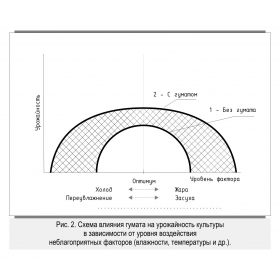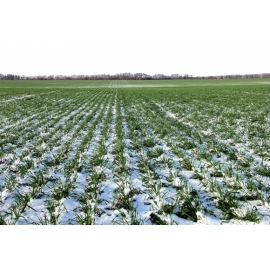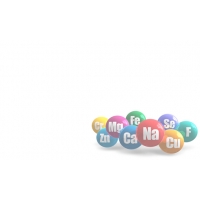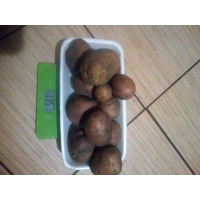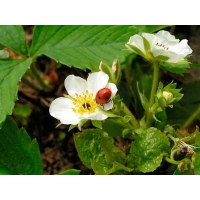Influence of humates on plant resistance to the effects of adverse factors and stresses
The humates impact on sustainable plant development. Dependence of the humates effectiveness on the degree of plants development optimal conditions deviation
The most important feature of humates biological activity is the increasing of plants resistance to the effects of adverse factors and stresses, in the expanding of the range of climatic and other conditions for their survival and fruiting. Humus substances – are not a random product in the chain of organic residues, but a necessary interconnecting piece in the evolution of living and non-living matters, the most important factor of life processes sustainability. For this reason the effect of humates use is the higher, the greater the effect of the adverse factor or the greater the deviation from plants development optimal conditions.
The fundamental difference between humates and many other biologically active substances is that they increase the resistance of plants not to some certain factors of the environment, but directly increase the resistance of the organism to the impact of any factor, compensating the lack of natural protective resources. Our scientists supposed that this is due to the fact that the action of humates is targeted at normalizing and stimulating precisely those leading processes of cellular metabolism, which are inhibited or blocked by adverse environmental factors. In this case, cells acquire an additional ability to quickly restore their vital structures and thereby resist the harmful effects of adverse conditions. One can think that the plant uses all the diversity of the molecular composition, chemical, energy and biological potential of humates, and chooses from the whole variety of nutritional, protective and stimulating properties precisely those that are most needed at the moment to resist the action of specific factors hindering development. And since many adverse factors in real conditions will necessarily be part of the current period of time, then the positive result of the compensation mechanism, laid in the humate nature, will exert almost always.
This feature of humates is illustrated in Fig. 7. This picture is largely provisional, since the real dependencies are multifactorial and complex, but with its help the main regularities are traced.

Fig. 7 Humate impact on yield stability depending on the level of the influence of adverse environmental factors.
In this figure, the axis of ordinates reflects the yield, and abscissa – the level of growth factor deviation (nutrition, sunniness, humidity, temperature, etc.).
Curve 1 determines the dependence of the crop yield on the level of the external adverse factor in control (without processing with humate) and limits its fruiting or survival. Curve 2 determines the yield and viability limits of plant processed with humates. The crosshatched area reflects the effectiveness of humate application. The yield ratio of the treated and untreated plants at the optimum point is minimal and with the deviation from the optimum it increases. Thus, when using humates in conditions of unstable climate and the effects of various adverse factors, yields tend to be maintained at the same level as with optimal conditions, but at the same time the limits of stability of these parameters and viability (survival) after processing with humates are considerably expanded.
Humate protective effect under plants development conditions deviation from optimum was noted by many researchers. But we want to pay more attention to the expansion of fruiting and vitality limits, which is of great practical interest.
So in non-guaranteed agriculture area the possibility of future harvest loss or crop survival after impulse (short-term late frost) or prolonged (cold dry winter, prolonged summer drought or rainy summer with rare sunny days) effects of the adverse factor are of great practical importance. In this case, the main criterion for the humate effectiveness is no longer yield, but the fact of plants salvation from death, which is especially important for perennials, when the damage from their death significantly exceeds the cost of a crop of one year. For more information on the impact of humates on stress of various natures, see section 2.3. But several examples of our own practices that support this statement are appropriate here. Thus, in 1963, in Eastern Siberia (the village of Oyok), due to the use of potassic humate, the maize yield was saved after a severe chill (-90C); in 1996, a both crops of potatoes and berries were saved in city of Angarsk after chill to -120C on June 19; in 1998, the crop of flowers and ornamental plants was saved in the company "Fleur" greenhouses (city of Angarsk) after full swamping as a result of catastrophic flood; in 1998 on the Steve Groff's farm the yield of maize and cauliflower was saved after drought (USA, state Pennsylvania).
Due to climate change on the planet and global warming in the agricultural regions, the instability of climatic conditions increases, so the need of humates use to protect plants from adverse weather conditions will increase every year.
Read the continuation of an article
Related Articles
Секреты успешной зимовки озимых культур
Фирмой Agro.bio разработан продукт, идеально отвечающий потребностям озимых зерновых в процессе подготовки к зимовке.
What contributes to the accumulation of nitrates in plants? Danger to plants.
The inclusion of nitrates in organic compounds in plants occurs both in the roots and in the leaves, and depends on the modes of nutrition of plants and the conditions of their growth.
List of articles for the category from the blog Minor-nutrient elements
Articles list
Ukraine has an agrarian orientation of the economy and, in the modern context, one of the most perspective areas for agriculture is the use of organic products, based on the application of purely natural components, that the company AGRO.BIO manufactures and offers – concentrated liquid POTASSIC HUMATE, which helps to restore the natural components of the main active environment – the soil – rationally and effectively.
The soil environment does not always contain the enough amounts of nutrients necessary for plant growth and development, but this disadvantage can be improved by additional fertilization, in particular with POTASSIC HUMATE BALLASTLESS made of LEONARDITE produced by AGRO.BIO. It is an ecologically safe multi-nutrient fertilizer and growth stimulator of organic origin for agricultural plants promoting the increase of soil fertility.
In order to make it easier for you to get an understanding of our products, the articles about potassium humate and multicomplexes are uploaded below.
 English
English Українська
Українська Русский
Русский Espanol
Espanol French
French عربي
عربي

